► A year and a bit with the tiny Kei-terham
► How fun is the three-cylinder entry-level Seven?
► Read all 13 months of our daily driver blog
Month 13 running a Caterham Seven 160: the conclusion to our long-term test
I racked up 11,578 miles in my long-term Caterham over the last 13 months – and my god, every single one of them was an absolute pleasure. More than a few eyebrows were raised among friends and family when I told them what was landing on the driveway and for how long. To be honest, I had no idea what it would be like using a Seven as everyday wheels. Most, if not all owners use theirs as trackday and weekend weapons, wheeling them out when the roads are dry and the sky is blue. I would be driving it every day, no matter where I had to go or what the weather.
Such an uncompromising car calls for a lot of compromises from the driver. I had no problem slithering down into the surprisingly-spacious-once-you-are-in cabin wearing earplugs, dinky suede driving booties, a hat of sorts and a warm jacket for pretty much every journey. It seemed like a very small price to pay for the generous serving of driving pleasure that the 160 served up with every twist of its key.
For anyone brought up on driving traditional cars – you know, those with doors, and roofs and radios and insulation and electric everything – the pared-back purity of the Caterham driving experience is difficult to describe. This is a car that never feels anything but electrifyingly vibrant, as if it were hardwired into your cortex.
With just 80bhp on tap, the lightweight 490kg 160 sits at the bottom of the Seven performance ladder. By Seven standards it’s tardy, by traditional car standards it’s plenty quick, but the trick the 160 pulls is that it feels ridiculously rapid. The steering wheel is a live thing in your hands, the engine wails and howls with a ferocity that belies its capacity and output, the gearlever snicks through its gate with a beautifully mechanical precision, and the biddable chassis feels pin-sharp. Clocking on at 70mph is a sensory overload most supercars couldn’t match at twice that speed.
What also shone through on even the coldest of January days was its indefatiguable sparkiness. It always felt full of brio and effervescence, always keen to tackle any road as fast and as sideways as you dared, and then go back again and tackle it again. Despite being redlined in pretty much every gear every day, that little blown 660cc triple was surprisingly light on fuel, returning an impressive overall average of 44.1mpg for a realistic 350-mile range. A single £160 service aside, there were no other costs incurred.
We had a few gremlins over the year. The gearbox linkage needed minor fettling, the ignition barrel needed replacing, and a weeping brake line saw it out of action for a few days. Impressive, for what is ostensibly a low-volume hand-built car. All repairs were carried out under warranty.
If I had to make a wish list of improvements it would be short. No, not more power – the grunt-to-grip balance is spot on – but I’d like to have more safety equipment than a seatbelt and a rollover bar. Sevens are small, but meeting Japanese kei standards means the 160 is even smaller. In traffic, Qashqais are terrifyingly enormous, Range Rovers block out the sun, and artics feel like land-bound aircraft carriers. Anti-lock brakes, traction control and a couple of airbags would be most welcome but their development and production would probably bankrupt Caterham three times over. Pity.
During the 160’s last month in my keep I made the foolish error of finding out how much it would cost to buy it through a Caterham financial package. The thought of me handing over its keys was just too depressing to think about. Owning it was just out of reach, even wearing my most creative accounting hat, and knowing how steadfastly Caterhams hang on to their values. But one day…
So after 13 months the 160 has gone. Black armbands all round. I was genuinely upset when I handed it back. It filled me with anticipation every time I set off, and with regret every time I turned off the engine. It made every journey an event and it made me a better driver. It’s been the best motoring year of my life.
By Ben Whitworth
Month 12 running a Kei-terham: the brakes leak
Leaky brake lines have put the 160 out of action. It happened on my morning commute, when a slack-jawed TT driver ahead pulled out to pass a cyclist. Without reason or warning – clear road ahead – he changed his mind, slammed on the brakes, swung back in to the left lane, almost flattened the cyclist and caused me to undertake a heart-in-mouth emergency stop. This stressed a joint in the Seven’s brake line, resulting in a brake fluid leak, and a trailer ride to Crawley for repair under warranty.
By Ben Whitworth
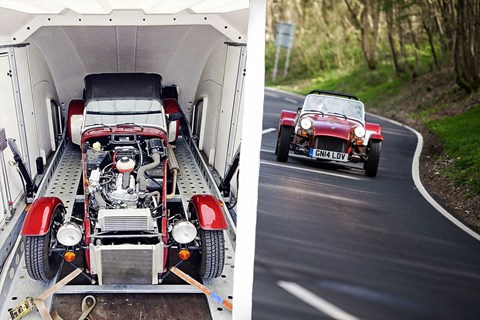
Month 11 running a Seven 160: a trip to the Caterham Academy!
The Seven is a superb road car, and an even better track car, so this month I visited Castle Combe to get a taste of Caterham’s Motorsport Academy. Just over 900 drivers have passed through the academy since its inception 20 years ago, including motorsport boss Simon Lambert who competed in the first academy, won his first race and came second overall. He was such an enthusiastic Caterham owner that he went to work for the company and has been there for the last 15 years.
The Academy works so: for £23k you get a self-build road-legal track car, the requisite medical and ARDS course, as well as engineering support and race engineers for five races and two sprints throughout the year. Everything you need to go racing except skidlid, race suit and talent. What you can’t have though, is experience. The Academy only accepts absolute novices.
Sure, 23 large is low-mileage Cayman money, but in the wedged-up world of motorsport, it’s peanuts. ‘We want to be the best at affordable club racing and we’re very realistic about our position on the motorsport ladder,’ says Lambert. ‘You can’t spend your way on to the front of the grid in a Caterham – and that’s exactly the way we want it.’
The five races are 15 minutes long, which sounds ludicrously short, but from behind the novice wheel that’s a long time to be screaming into your helmet while rubbing wheelarches. And there are no prizes for race winners – just a massive knees-up at the end of each weekend to reward everyone. Very democratic.
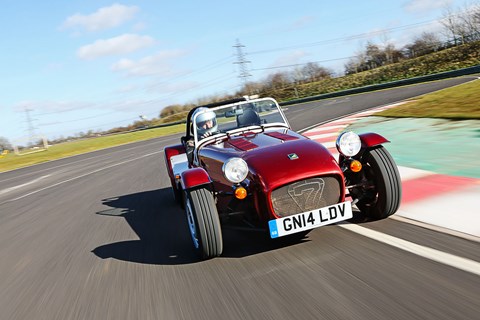
On average three-quarters of the drivers progress to the next tier. After the Academy comes the Roadsport Race Series – 14 races over seven weekends – using the same Academy car but with chassis upgrades. Then there’s the Tracksport, Supersport and Superlight race series where the racing gets progressively more hardcore.
Driving the 160 around a sunny Castle Combe was a delight. With its modest power and waterbiscuit-thin tyres, it felt completely at home four-wheel drifting through Quarry and Camp, and wailing along Hammerdown and Dean. It was so biddable and keen, like it was having as much of a laugh as I was.
The Academy car is a Caterham Seven with 125bhp 1.6-litre Ford power. The Sigma unit drives the rear wheels through a five-speed ’box and an open diff; there are discs at each corner and the tyres are bespoke low-grip Avon CR322s.
Stepping into the Academy car wasn’t like going from korma to phaal. Yes, it felt noticeably pokier, with sharper throttle responses, but as with the 160, the immediacy, the responsiveness, the adjustability were all there in spades. It felt confidence-inspiringly secure and friendly – a perfect car for motorsport novices.
By Ben Whitworth
Month 10 running a Caterham Seven 160: it’s not friendly in foul weather
My two biggest gripes about driving the 160 in bad weather are:
1) The windscreen wipers are rubbish. They’re six-inch strips of rubber that squeal and smear themselves across the pillar-box screen, and they do more to impede visibility than enhance it. Utterly at odds with the relatively high-tech heated screen.
2) The headlamps are equally pants. Two geriatric glow-worms in a pair of grimy jam jars would do a better job of lighting the road ahead. Some new wipers and those bluey high-intensity bulbs beckon.
By Ben Whitworth
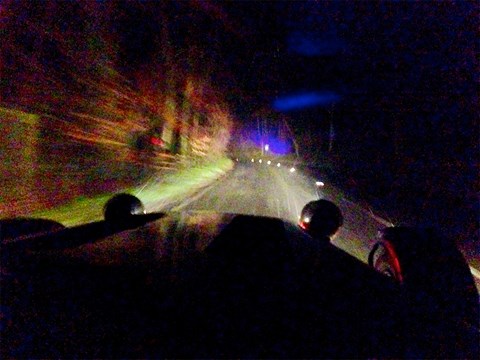
Month 9 running a Caterham Seven 160: a reality check
Acceptance. There’s a lot of it to be done when you drive a Caterham every day. Much like you have to accept that a Smart ForTwo is going to be short on luggage space and big on urban agility, you have to accept the Caterham for being immense on driving pleasure but a little short in other areas. It’s quite a list.
Roof-up entry and exit calls for the complete abandonment of dignity. You need to wear narrow racing booties when driving and remember to remove them the moment you inelegantly get out for fear of looking like a twit. You have to bundle up against the cold. Luggage space is laughable. Apart from the screams of terror from your passenger, there is no in-car entertainment whatsoever. It has the turning circle of an artic. Only your driving smarts separate you from becoming a crumpled ball in a field. The headlamps of other cars seem perfectly positioned to blind you. And at speed, the cabin is like a thrash metal concert, but louder.
But to bash the Seven for any of these is to miss its point. This car dishes up such an intense, pared-back driving experience that everything else feels utterly inert and leaden. Which is why I’m happy to accept the Caterham – and all it entails – in its entirety.
By Ben Whitworth
Month 8 running a Caterham Seven 160: appearances can be deceptive
I adopt a pretty combative attitude whenever I unfold myself behind the 160’s dinky wheel. Why? Well, maybe it’s the Seven’s combination of pocketable size – it disappears behind a parked MX-5 – and modest 80bhp performance that makes other drivers think it’s An Easily Passable car. But in my hard-fought quest of winning that most vital of commuting pursuits – To Overtake And Not Be Overtaken – the 160 swings with a killer punch.
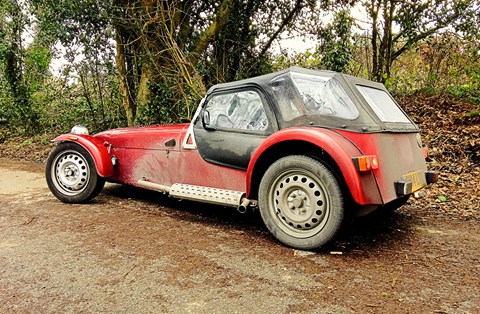
The key to unlocking the full potential of the 160’s performance is to maintain as much speed as possible for as long as possible. Against me, I have atrocious aerodynamics – lifting off at speed is like driving into treacle: massive gaps between gear ratios and not one electronic driver assistant to keep me from interfacing with the scenery. With me, I have low weight, a talented chassis capable of handling everything the feisty engine can throw at it, quick hiccup-feck-ditch steering and a surprisingly compliant ride that glues all four wheels to even the worst of roads.
The result? I cover ground quicker than I would in something thick-ankled and laden with an endless array of electronic acronyms. And have way more fun in the process.
By Ben Whitworth
Month 7 running a Caterham Seven 160: we swap our 160 for the crazed 620R
A couple of weekends ago I swapped the 160 for the madcap 620R. Now, Caterham has an unimpeachable record for building some of the world’s most decidedly unhinged performance cars, and it pleases me greatly to say that the 620R continues that tradition, carrying the banner of insane synapse-snapping performance aloft with pride.
The 620R – like the 160, the name refers to its outlandish power-to-weight ratio of 620bhp per tonne, with the R for Racing – started life as the R600 track-special. Wheeled out in 2012, Caterham announced to us wide-eyed media types that had just come in from test-driving it that a roadgoing version was under development. The 620R, the most powerful Caterham to ever smoke its rear wheels, made its debut 18 months later, most aptly, at the 2014 Goodwood Festival of Speed.
If Satan decided on a road trip, he’d do so in the 620R, because it’s easily one of the most terrifying, intoxicating and electrifying cars I’ve ever driven. This is a demonic car all about violent power and ferocious pace.
Where the 160 makes do with just 80hp, the 620R is powered by a bespoke 2.0-litre Ford Duratec engine that’s breathed on by a supercharger to deliver – take a big breath – a faintly ridiculous 311bhp at 7700rpm and 219lb ft of torque at 7350rpm. This, remember, in a car that weighs a fraction over 500kg. It drives the rear wheels through a six-speed straight-cut sequential ’box and a very aggressive limited-slip differential.
The rest of the car draws heavily on Caterham’s considerable motorsport success with track-inspired suspension, ultra-quick steering, racing brakes and sticky Avon tyres. The result is a road car that will catch and devour any car this side of a Bugatti Veyron Super Sport. It is that savagely fast.
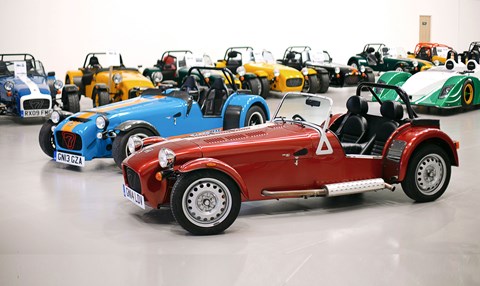
Slam through its gearbox – there’s no need to use the clutch when you’re on the move, you just lift the throttle slightly and pull back the stubby shifter for whipcrack upshifts – and the 620R will scream to 62mph in just 2.79 seconds. Yup. That’s 2.79 seconds – quicker than a McLaren P1, and just two-tenths of a second behind Porsche’s 918 Spyder. That’s very quick company indeed. Even its 155mph top speed seems outrageous given the size of the hole its blunt, open-wheeled shape has to punch through the air.
Throttle response in any gear and at any revs is scalpel sharp – there’s no mid-range lethargy or top-end breathlessness, just instant mouth-drying pace that pulls in the horizon so quickly that you need to heavily recalibrate your distance-speed-time triangle.
An HMRC tax inspection aside, not many things frighten me at my age. Fully depressing the 620R’s throttle frightens me. The engine pulls through to its 8000rpm redline with such brutal aggressiveness, dishing out so much grunt that it will spin the rear wheels in third, fourth and fifth, in the dry at three-figure speeds. You can change up early at 5000rpm and still cover ground at a ludicrously fast rate, but you’ll need to find a lot of teeth-gritting courage and some big open roads to red-line this car through the gears.
If the 620R’s explosive straight-line speed is jaw slackening, then its cornering ability is simply expletive inducing. Once its trick Avon race tyres are warm and sticky this stubby four-wheeled missile will slice its way through curves and bends at the most insane speeds without any sign of understeer or twitchiness. You don’t lob the 620R into a corner and slide it through with a grin on your face as you would the 160. No, this monster is way too planted and grippy for sideways showboating. Get this car out of shape and you’ve either got things horribly wrong or you’re wearing stain-proof brave pants, and wearing them well.
At the time of writing this, two dozen certified loons have purchased a 620R, and having experienced its inimitable performance, it would be on my confirmed list in my lottery-win garage. The other cars would be a 1987 Mercedes-Benz 560 SEC, a 2002 Honda NSX-R and a 2003 Noble M12 GTO 3R, if you’re asking. Those two dozen buyers, along with the 100-odd sales of the 160 this year will make 2014 Caterham’s best year to date.
By Ben Whitworth
Month 6 running a Caterham Seven 160: meeting a Ferrari 458 Speciale
It may seem ludicrous to line up our Caterham next to the Ferrari 458 Speciale featured in last year’s Sports Car Giant Test – after all our Seven costs £22,355, has a 660cc triple and gets by on 80bhp, while the Speciale is a little dearer at £208,090 and is powered by a 4497cc V8 that develops 597bhp. But performance and price aside, these cars are intrinsically linked by their purity of purpose – peeling away the layers that sit between the driver and the road.
Getting out of the Ferrari and in to the Caterham isn’t the phaal vs korma relationship you’d expect. It’s more like swapping a Eurofighter Typhoon for an Extra 330SC. Different approach, same exhilaration. Both cars immerse their drivers completely in the experience, via wrist-flick steering and electric throttle response, immaculate body control and whipcrack gear changes – the cars may be divided by technology but they both achieve the same goal.
In other news, the Seven’s immobiliser went on the blink last week. The tiny glass-tubed transponder in the keyfob that communicates to the immobiliser died, leaving the Caterham stranded. It was taken back up to Caterham in Crawley where it was fitted with a new immobiliser. No other problems this month – just 546 superb sideways miles.
By Ben Whitworth
Month 5 running a Caterham Seven 160: mechanical gremlins attack
The Seven has been in the wars. Something rather unusual happened when I got back to the car after grabbing a coffee. It wouldn’t start. The key was locked solid in the ignition barrel. Which meant I could neither start the engine to get home, nor turn off the ignition and leave the car to go and get assistance.
Enter RAC man Charlie. He dismantled the ignition barrel and tried to start the car, but it remained immobile. After a frustrating hour of fumbling under the dash, we decided the best bet was to jump-start the car, and for me to head home and then disconnect the battery.
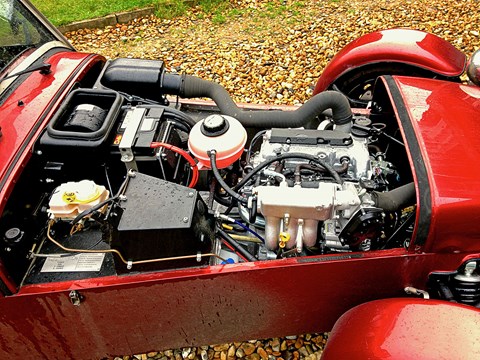
The car was collected the next day. The ignition barrel and starter motor were replaced, and a starter button fitted (a £60 option when new), all under warranty. Fortuitously, it was also due its 4000-mile service, which was carried out at the same time. The £160 service included a bumper-to-bumper inspection which resulted in the following: a reduction in toe-out on the rear wheels, a resealed floor to eliminate a water leak, and a secured steering wheel hub which had started to rattle.
It’s easy to have a pop at a small company like Caterham, and make snide told-you-so comments about reliability. But let’s not forget that few automakers can post blemish-free reliability records. Just ask some of the big hitters like Toyota and BMW. Given the budgets that Caterham works with – Audi probably spends more on posh teatime biscuits in a day than Caterham spends on product development in a year – the cars it produces are, I believe, bloody impressive.
By Ben Whitworth
Month 4 running a Caterham Seven: a trip to the Top Gear test track
We’ve been getting out and about, the 160 and I. Caterham has a devout following, so I wangled an invite to one of the Lotus Seven Club’s key summer meets. The event was held at Dunsfold airfield which, apparently, is used for some obscure TV show. It was a superb day with a strong turnout of over 100 Caterhams ensuring the slalom, sprint, circuit and wet skidpan exercises were busy.
It was a pleasure to mooch about because no two Sevens are alike. Their owners are similarly disparate – unhinged Caterham fanaticism aside, they’re all interestingly different in age, occupation and background. They were particularly interested in the new 160, were impressively knowledgeable about its development and gave it a unanimous thumbs-up.
Our second day out was a jaunt up the road to Goodwood for one of its sell-out Breakfast Club meetings. I entered the 160 into the Soft Top Sunday event, and hooked up with some of the marketing chaps from Caterham who were keen to see what sort of reception the 160 received.
They brought along the insane 620R to neatly bookend the current Caterham range. The pair proved magnets for Caterham fans who spent hours in the sun weighing up the pros and cons of both cars. Lots of the former, very few of the latter, of course.
In other news, the 160 spent a few days at Caterham’s shiny new premises in Crawley having its gearbox tweaked. Part of the linkage had worked loose and blocked the gate, leaving the car with just third and fourth. The repair was quickly sorted out under warranty, and the car was cleaned and buffed for collection. Happy days…
By Ben Whitworth
Month 3 running a Caterham Seven 160: nine surprises
Here are nine surprising things about the 160.
1) It’s highly susceptible to weight change, feeling quicker when running on fumes. Carry a passenger and a full tank and it’s like driving through treacle.
2) Its heater is searingly effective, instantly filling the cabin with volcanically hot air.
3) For all the performance available, it’s very economical, returning around 44mpg.
4) It bellows, howls and crackles with a barrel-chested soundtrack that wouldn’t sound out of place from something with four times the cylinder count.
5) It treats your ears and nostrils. Roof down, you can tell what the driver five cars ahead is smoking, you can hear cyclists wheezing, and you know when the local chippie is open.
6) The turning circle is rubbish. Eight-point car park turns are not cool.
7) The engine is crying out for a six-speed ’box. Changing from third to fourth is like falling off a cliff, and 4800rpm at 80mph in fifth is tiringly noisy.
8) The ride quality is waaaay better than you’d expect. It’s compliant and absorbent, making long trips doable.
9) And most surprisingly, my wife loves it. Having turned up her nose at everything quickish that I’ve brought home over the last decade, a summer evening blast behind the 160’s wheel instantly converted her.
By Ben Whitworth
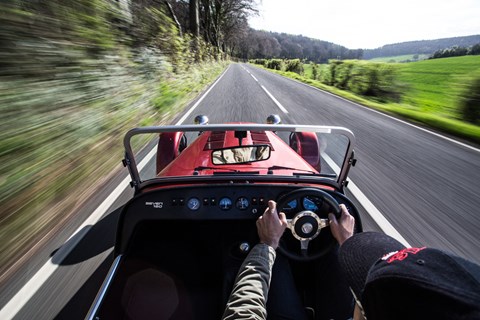
Month 2 running a Caterham Seven 160: less is more!
Where do I start to begin explaining how wonderful this car is? Unlike every other Caterham I’ve driven, the 160 isn’t about outright pace and eyeball-flattening acceleration. It’s all about the sensation of speed, the impression of covering ground at a riotous rate. In most modern cars 60mph feels slug slow. At that speed, the 160 makes you feel like you’re piloting the fastest thing on the living planet. The engine howls, the steering wheel writhes and wriggles, the suspension works overtime, the airstream is battering your face and the blacktop is just a few inches below your arse. The entire car feels like it’s in full attack mode.
The 660cc Suzuki triple may have thimble-sized pistons, but despite its Lilliputian size and outputs – 80bhp at 7000rpm and 79lb ft of torque at 3400rpm – the blown engine delivers the goods with hairy-chested determination. By Caterham standards, performance is modest with a 6.5 second dash to 60mph and onto a 100mph top speed – one hundred! – but the combination of thrummy baritone soundtrack and superb throttle response (the engine reacting instantly the moment you even think about adjusting teaspoon-sized pedal) create the impression of sound-barrier-busting pace, even if the tiny speedometer says you’re only doing 45mph.
Despite the water biscuit tyres and their postage stamp-sized contact patches, dry grip levels are astonishing. The nose scythes instantly into corners, and you have to work to unstick the rear boots. Flinging the 160 into a long sweeper as fast as you dare, and then balancing it on the fine line between grip and slide is a driver’s delight.
The small unassisted steering wheel is big on accurate and highly detailed information, constantly telling you about the conditions between tyre and tarmac. And the cherry on the top? I’m averaging 46.2mpg. I know. Quite incredible, given that I drive the Caterham like I stole it. This car is a stickleback in a world of whales. I love it.
By Ben Whitworth
Caterham Seven 160 diary notes: learning to climb in
Confession time: the taller members of the CAR team are struggling to get in and out of the Kei-terham. I’m 6ft 2in and cannot physically contort myself into the snug cabin with the roof up. My flailing limbs and long back are simply too inflexible to get in. It’s like an extremely embarrassing, painful – and ultimately unsuccessful – game of Twister.
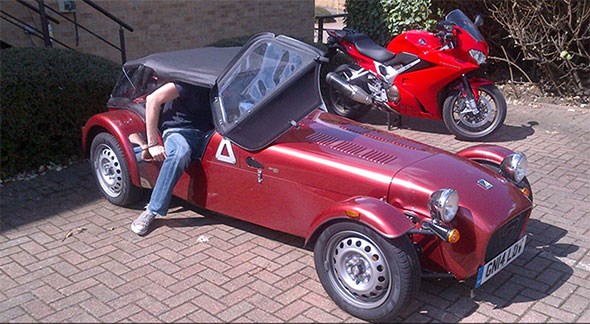
So my even taller colleague, 6ft 5in Ben Pulman, gave me a lesson recently (pictured in our gallery right). He somehow can slide one leg in first, stretch his spindly frame inside and then magic the second leg in. He still looks a bit of a contortionist in doing so – think daddy long-legs insect meets Cirque de Soleil – but he doesn’t have to unclip the hood to get in every time (my preferred ploy).
Once inside, things improve. Roof-off, it’s a cinch to climb onboard and I fit in the snug, narrow cabin quite happily. Okay, so I have to remove my shoes to use the pedals, but it’s effective. Snug. Sporting. Makes you smile. And that’s what a Caterham is all about.
By Tim Pollard
Month 1 running a Caterham Seven 160: the long-term test review
So then. We’ve gone from Dacia Duster to Caterham Seven 160. From a car that was all about logical and rational transport and nothing about driving, to a car that turns that equation on its head, and puts driving pleasure above every other consideration. We’ve always loved the Seven. Loved it for its purity of purpose, for the way it removes every unnecessary layer between the road and the driver, and for its ability to show up metal ten times more expensive.
The 160 may take up its position on the bottom rung of the Caterham ladder, but despite its pocketable dimensions and modest performance there’s something deeply appealing about its unerring focus on pure driving rather than outright tyre-blistering performance. It took a while to arrive, but it’s been well worth the finger-drumming.
According to David Ridley, Caterham’s chief commercial officer, the idea behind the 160 came about back in 2008 during a trip to Japan, the company’s third largest market after the UK and France. ‘We’d always thrown around the idea of a car specifically for the Japanese market, one that embodied the Caterham spirit but also qualified for “kei” status,’ explains Ridley.
For a car to fall into the kei class, and benefit from the attractive government-sponsored tax, parking and insurance benefits they enjoy, explains Ridley, it has to be no longer and wider than 3.4m and 1.48m, and power from its 660cc engine is capped at 63bhp.
‘At the same time, we were also keen to deliver a back-to-basics model with a simple drivetrain and a live axle. Over a decade ago we used to have a lower-cost live-axle chassis on the Seven, but that stopped in 2002 with the Vauxhall-powered Beaulieu run-out model, which had an Ital/Marina live rear axle. When the supply of that layout dried up we stuck with the De Dion and live-axle models.’
What started as an off-the-cuff comment at a late-night dinner slowly gathered momentum, developing into a single project that would address both Caterham’s desire for a bespoke kei car and a no-frills entry point into the Seven range. ‘We approached Suzuki in 2012 and after lengthy discussions, a commercial arrangement was eventually agreed upon where they would supply us with engine, gearbox and live rear axle for us to drop into the 160.’
The tried-and-trusted, ready-to-go K6A drivetrain comes from Suzuki’s Wagon R, Japan’s best-selling kei car since anyone can remember, and also appears in the Alto and Jimny. In Japan, this zingy little turbocharged 660cc triple delivers its 63bhp through a five-speed manual transmission, but in the UK the shoebox-sized engine has been fettled to dish up a big-hearted 80bhp at a wailing 7000rpm and a turbo-enhanced 79lb ft of torque at 3400rpm.
That’s right. A full 80bhp. Slightly less than a Smart, slightly more than a Ka. But remember this car weighs an anorexic 490kg, giving it a power-to-weight ratio of 163bhp per tonne. Comparing that to the 2.0-litre MX-5 (128bhp per tonne), the 1.6-litre Lotus Elise (157bhp per tonne) and Toyota GT86 (156bhp per tonne) should stop you sniggering. It will howl its way to 60mph in 6.5 seconds flat and top out at 100mph, while returning 57.6mpg and 114g/km on the combined cycle.
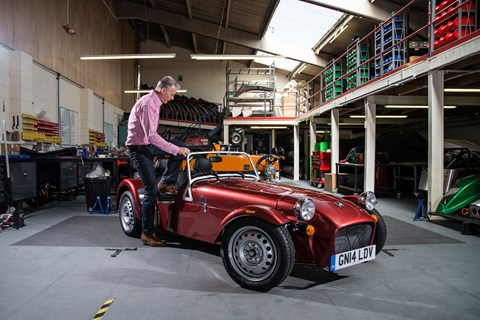
At 3.38m in length, the Seven didn’t have a problem meeting kei dimensions, but with its fat tyres and broad rear track to accommodate its independent suspension, it was always too wide. Which is why the kei-compliant 160 with its narrower live axle features dinky 14-inch steel wheels shod with biscuit-thin 155/65 profile Avon tyres that nestle beneath new slim-line rear wheelarches. Suzuki was so enamoured with the 160 that it invited Caterham to unveil the car on its stand at last year’s Frankfurt motor show.
Walk around the 160 and you’ll understand its enthusiasm for this diddy roadster. It’s beautifully proportioned, its combination of skinny tyres, glossy chrome work and exposed suspension giving it a style that’s both retro and fresh at the same time. Unsurprisingly, sales have shot off the chart and headed for the skylight. Ridley reckons Caterham will shift 150 160s in its first 12 months on sale, 50% more than initially anticipated, and a huge incremental sales leap for a company selling 500 cars a year.
Fifty of those will go to Japan in full turnkey guise, with the UK accounting for another 50. ‘We’re expecting that the simplicity of the 160 will strike a chord with people who like wielding spanners, and anticipate half of UK buyers will build their cars themselves,’ says Ridley.
With a DIY price of £14,995 and a turnkey price of £17,995, the 160 looks exceptionally good value. But unless you’re very familiar with Caterham’s approach to options, that OTR price is a little misleading. Once you lob in, as we did, a heated windscreen, roof and doors (£1250 together), adjustable leather seats (£500), a 50mm lowered floor (£395 but worth every penny when you’re 6ft 2in), a heater (£300) a 12V power socket (£110), stainless-steel rear-wing spats (£40) and a tasty aluminium fuel filler cap (£115), the price rises as quickly as your eyebrows.
We also indulged in a bespoke colour. This glorious Aston Martin Volcano (£1650) is a lustrous coppery red that perfectly complements this car, imbuing it with an dash of retro sophistication. That’s a £22,355 price tag. Yes, that’s a lot of money for an 80bhp roadster that looks like it went through a too-hot wash, and it’s uncomfortably close to the £22,995 Caterham will charge you for its 125bhp Roadsport. But then when you start adding a roof and so on to the Roadsport you climb aboard the same option spiral…
Rather foolishly, someone at Bauer Towers thought it would be a wheeze to have me visit Caterham’s Dartford production line to get my hands dirty finishing our 160’s assembly. Now, I can tell you in mind-numbing detail what pretty much any component of any car does and how it works. But point me at an engine bay and I’ll do a really good impression of Chevy Chase masquerading as a surgeon in Spies Like Us. Ineptitude notwithstanding, I was able to attach wheels, lights, exhaust and, err… stickers to the car with something approximating proficiency. I know my limits.
The spanner manhandling took a lot longer than I anticipated, mainly because I kept stepping back to gaze adoringly at what I was going to be piloting for the next six months. Reality will sink in quickly, I’m sure. I have two young children and a 102-mile daily commute, for starters – not an ideal backdrop for Caterham stewardship. But right now I don’t care. The sun is shining and all I want to do is head out of the factory and drive the wheels off it.
By Ben Whitworth